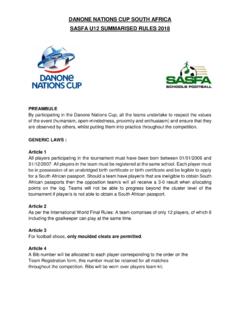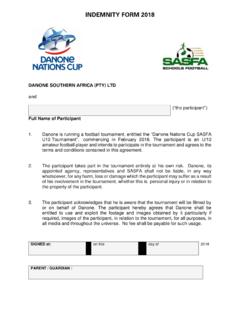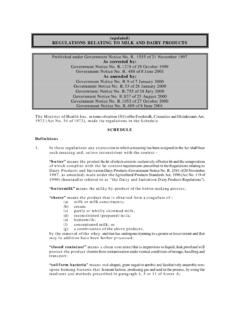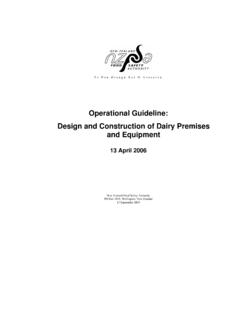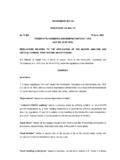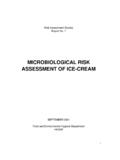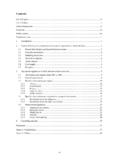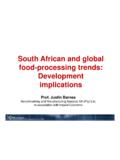Transcription of GOVERNMENT NOTICE …
1 3 STAATSKOERANT, 1 MAART 2010 No. 32975 GOVERNMENT NOTICE GOEWERMENTSKENNISGEWING DEPARTMENT OF HEALTH DEPARTEMENT VAN GESONDHEID No. R. 146 1 March 2010 FOODSTUFFS, COSMETICS AND DISINFECTANTS ACT, 1972 (ACT 54 OF 1972) regulations relating TO THE LABELLING AND ADVERTISING OF FOODSTUFFS The Minister of Health has, under section 15 (1) of the Foodstuffs, Cosmetics and Disinfectants Act, 1972 (Act 54 of 1972), made the regulations set out in the Schedule hereto. Reproduced by Sabinet Online in terms of GOVERNMENT Printer s Copyright Authority No. 10505 dated 02 February 1998 4 GOVERNMENT GAZETTE. 1 MARCH 2010 TABLE OF CONTENTS I Regulation number Table of contents Title of heading I 1 2-15 16-49 50 50 -53 54 55 56 Annexure number Annexure 1 Annexure 2 Annexure 3 Annexure 4 Definitions i General Provisions Special Provisions Nutritional information Claims Exemptions Repeal Commencement I Reference index Title of A It.
2 Categories of additives that may be identified by their category name in a list of ingredients Prescribed nutritional information declaration format and conversion factors Nutrient Reference Values for the purpose of food labelling dstuffs exempted from a date of durability i Annexure 5 Evaluation of protein quality for the purpose of when a protein claim IS made Annexure 6 The manner of expression of energy, nutrient or other substances values found in foodstuffs in the table with nutritional information 2 Reproduced by Sabinet Online in terms of GOVERNMENT Printer s Copyright Authority No. 10505 dated 02 February 1998 5 STAATSKOERANT, 1 MAART 2010 SCHEDULE 1. DEFINITIONS In these regulations , any expression to which a meaning has been assigned in the Act shall bear such meaning and, unless inconsistent with the context "address" means a physical address in the Republic of South Africa and includes the street or road number or name and the name of the town, village or suburb and, in the case of a farm, the name or number of the farm and of the magisterial district in which it is situated.
3 "added sugar" means any sugar added to foodstuffs during processing and includes but is not limited to sugar as defined by regulations relating to the Use of Sweeteners in Foodstuffs under the Act, honey, molasses, sucrose with added molasses, coloured sugar, fruit juice concentrate, deflavoured and/or deionised fruit juice and concentrates thereof, high-fructose corn syrup and malt or any other syrup of various origins; "allergen" means any substance that causes an allergic or other adverse immune response; "allergen cross-contamination" means the presence of any common allergen not intentionally added to a foodstuff, which is present in such foodstuff as a result of the cultivation, production, manufacturing, processing, preparation, treatment, packing, packaging, transport or holding of such foodstuff or as a result of environmental contamination; "allergen control program" means a program for the identification and control of allergenic ingredients and for the prevention of allergen cross-contamination at every stage of the manufacturing process, from harvesting through to packaging and retailing; "annexure" means an annexure to these regulations .
4 "antioxidant" means either an additive that prolongs the shelf life of foods by protecting against rancidity or colour changes or other deterioration caused by oxidation or means a substance that inhibits oxidation or inhibits reactions promoted by oxygen or peroxides; "audit" in terms of certification means a systematic and functionally independent examination to determine whether activities and related results comply with planned objectives or legislative requirements; "batch" means a definite quantity of a commodity produced essentially under the same conditions, not exceeding 24 hours; 3 Reproduced by Sabinet Online in terms of GOVERNMENT Printer s Copyright Authority No. 10505 dated 02 February 1998 6 GOVERNMENT GAZETTE, 1 MARCH 2010 "brine" means a solution of sodium chloride in water where the solution is used for curing, flavouring and/or preserving the foodstuff; "bulk stock" means either a container that is used to display several individual units suitable for sale by itself, or several units, which are pre-packed or wrapped for the purpose of bulk sales or foodstuffs, which are offered for sale to consumers in quantities of their own choice from a large-scale container.
5 "catering establishment" means any establishment including a vehicle or a fixed or mobile stall where, in the course of business, ready-to-eat foodstuffs are prepared for direct sale to the consumer for consumption; "cereal" means a product derived from the grain or edible seed of any cultivated grasses of the family Poaceae, which may be used as a food, wheat, rice, oats, barley. rye, maize, millet et cetera; "certification" means the procedure by which ISO 65 accredited, certifying organisations provide written assurance that a product. process or service is in conformity with certain standards; "certifying organisation" means an organisation performing conformity assessment against specified requirements through an audit process resulting in a certificate being issued; "chilled" or "refrigerated" means stored at an appropriate temperature ranging from O C to 7 C for a spesific product type, but specifically means a maximum core temperature of 4 C for raw unpreserved fish, molluscs, crustaceans, edible offal, poultry meat and milk.
6 And for any other perishable food that must be kept chilled to prevent spoilage, a maximum temperature of maximum 7 C; "chocolate confectionery" means any foodstuff that is meant to be consumed as a sweet snack and which contains chocolate as described in Codex and/or other ingredients; "claim" in relation to a foodstuff, means any written, pictorial, visual, descriptive or verbal statement, communication, representation or reference brought to the attention of the public in any manner including a trade name or brand name and referring to the characteristics of a product, in particular to its nature, identity, nutritional properties, composition, quality, durability, origin or method of manufacture or production; "Codex" means the latest adopted version of the relevant text of the Codex Alimentarius Commission of the Joint FAOIWHO Food Standards Programme; 4 Reproduced by Sabinet Online in terms of GOVERNMENT Printer s Copyright Authority No.
7 10505 dated 02 February 1998 7 STAATSKOERANT, 1 MAART 2010 N' "colourant" means any substance described as such in the regulations relating to Food Colourants published under the Act; "common allergen" means egg, cow's milk,crustaceans and molluscs, fish, peanuts, soybeans, tree nuts and any significant cereals, as well as ingredients derived from these foodstuffs that has retained its allergenicity in the final product; "comparative claim" means a claim that compares the nutrient level(s) and/or energy value and/or alcohol level of two or more similar foodstuffs; "compound ingredient" means any ingredient, which itself is composed of two or more ingredients; "container" means any packaging of foodstuffs for sale at retail level or for catering purposes for delivery as a single item or for free sample handout purposes, whether by completely or partially enclosing the foodstuff and includes wrappers for individual and multiple-un it-packs; "contaminant" means any biological or chemical agent, foreign matter or other substance not intentionally added to the food which may compromise food safety or suitability so that it does not meet a standard or requirement determined by any law.
8 "cold-pressed" in terms of edible vegetable fat and oil manufacturing, means the oil has been obtained by applying mechanical procedures, such as expelling or mechanical pressure, in the absence of light, without the application of external heat where the temperature of the process never exceeds 50"C (122"F) and where purification may have been accomplished by washing with water, settling, filtering and centrifuging only; "daily serving" means the average daily intake in terms of a food vehicle; "dairy product" means a primary dairy product, a composite dairy product or a modified dairy product as defined by the regulations published in terms of the Agricultural Product Standards Act, 1990 (Act No, 119 of 1990) as amended; "date of manufacturing" means the date on which the food becomes the product as described; "date of minimum durability" ("Best Before" or "Best Before End") means the date which signifies the end of the period under any stated storage conditions during which the product will remain fully marketable and will retain any specific qualities for which tacit or express claims have been made, However, beyond the date the food may still be perfectly satisfactory.
9 5 Reproduced by Sabinet Online in terms of GOVERNMENT Printer s Copyright Authority No. 10505 dated 02 February 1998 8 GOVERNMENT GAZETTE, 1 MARCH 2010 "deflavour" means the intentional removal of the bulk of volatile and non-volatile natural flavourings from fruit juices or fruit juice concentrates; "deionise" in terms of fruit juices or fruit juice concentrates means the intentional removal of the bulk of mineral salts from fruit juices or fruit juice concentrates; "dietary fibre" or "fibre" means edible carbohydrate polymers with ten or more monomeric units, which are not hydrolysed by the endogenous enzymes in the small intestine of humans and which occur naturally, or which have been obtained by physical, enzymatic, or chemical means, in fruits, vegetables and cereals consumed ordinarily as food and measeared as non-starch polysachharides (NSP), but exclude novel fibres; "drained weight" means the net mass of the remaining solid component after the liquid medium has been drained; "endorse" means to confirm or conveyor declare an approval of a particular foodstuff in any manner but exclude certification.
10 "enrichment" means the voluntary addition by a manufacturer of one or more nutrient(s) to a foodstuff, whether or not it is normally contained in the food, with the sole purpose of adding nutritional value to the food, but excludes "fortification"; "evidence-based nutrition" means the application of the best available systematically assembled scientific evidence in setting nutrition policy and practice; "fat" or "lipid" means the total amount of chemically extractable fat, including phospholipids, determined according to the appropriate extraction method for animal and plant fats; "flavouring" means a flavouring substance intended to be added in small amounts to foods and of which the primary purpose is to impart, modify or improve the flavour of foodstuffs rather than to enhance nutritional quality, is not intended to be consumed on its own and exclude substances that have an exclusively sweet, sour or salty taste ( ,sweeteners, table salt, vinegar).
